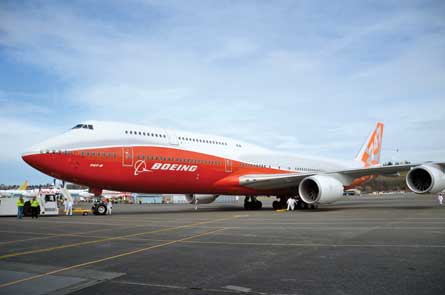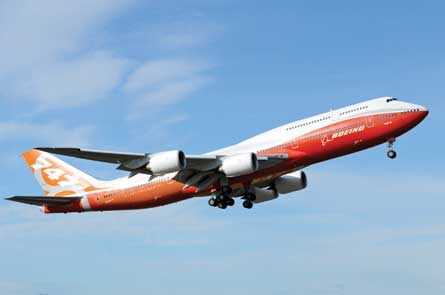In the earliest days of the 747-100 programme, windtunnel testing revealed that the loads on the wing of the jumbo jet were not distributing across the structure properly. The wing would have to be twisted 3° at the root, effectively redesigning it after parts had already begun fabrication.
Boeing faced a design crisis. Starting from a clean sheet of paper to redesign the wing and centre wing box - prompting a massive, costly delay - threatened the existence of the company, the programme's original chief engineer Joe Sutter reflected in his memoirs.
 |
|---|
© Boeing |
The 467-seat aircraft is the largest passenger jet in Boeing's history |
A competing engineering leader had commandeered an auditorium to begin the redesign, although Sutter and the 747's primary structural engineering leaders quickly made a preliminary determination that a less radical solution would solve the problem - without a complete redesign. Rather than twist the entire wing at the root, the outboard wing would be twisted to deliver the 3° twist, alleviating 80-90% of the loads on the wing structure. The change would forever be known as the "Sutter twist".
Four decades later, the 747-8 programme was in the midst of a similar crisis after early flutter tests in the spring of 2010 revealed a 2.3Hz ±2.5cm (1in) vibration - or limit cycle oscillation - in the jumbo freighter's wing. The challenge was clear: come up with a way to dampen the oscillation without adding thousands of kilogrammes into the wings and shaving significant performance capability.
While the Federal Aviation Administration says "the sustained oscillation is caused by an unstable aeroelastic mode", the vibration does not worsen and is considered "stable" if it maintains the same frequency and amplitude for a given excitation input and flight condition. Nonetheless, the regulatory body's conclusion was clear, deeming the vibration to be an aeroelastic instability in the aircraft structure.
 |
|---|
© FlightBlogger |
For the first flight, the aircraft was painted in bespoke red, white, grey and organe scheme |
The simple but inspired solution leveraged one of the 747-8's key upgrades not found on the earlier -400. Boeing would use the new aircraft's new closed-loop fly-by-wire outboard aileron to dampen out the vibration. Just as yaw damper is used to automatically minimise yawing oscillations in a dutch roll, the outboard aileron would be used to offer an equal and opposite load to nullify any oscillations in the wing.
Todd Zarfos, the 747-8's vice-president of engineering, says the solution "was very elegant and easily incorporated and it was certainly advantageous to have a fly-by-wire outboard aileron".
The system, known as the outboard aileron modal suppression (OAMS) system automatically activates when the aircraft encounters the conditions that have been found to cause the wingtip's "virtually imperceptible" vibration, says 747 chief pilot Mark Feuerstein.
The implementation of OAMS, which is the brainchild of Boeing engineer Pio Fitzgerald, marks the first time a roll-axis flight control surface has been used by Boeing to eliminate a structural oscillation.
However, by July 2010's Farnborough air show it became clear that flight-test discoveries had placed the 747-8F's schedule in jeopardy. Boeing warned the freighter's first delivery "could slip into 2011" due to the combination of the wingtip vibration and an underperforming aileron power control unit.
On 30 September, Boeing officially shifted first delivery, to Cargolux, to mid-2011, holding in place the 747-8 Intercontinental's first delivery - to completion for a VIP customer believed to be the Kuwait government- at late 2011.
As a result of over-optimisation of each of the three 747-8F test aircraft, Boeing would grow the flight-test fleet to five, expanding the role of RC503 and RC523, which first flew on 22 July and 3 February, respectively.
The flight-test evaluations of the OAMS system began in late September aboard Boeing's third 747-8F test aircraft, RC522, refining the system and its handling qualities under a variety of different payloads in January, February and March. In February, at the time of the 747-8I's unveiling, Zarfos said: "We know [OAMS] will work and now we just have to go through the last aspects of certification associated to that."
He added that there was some debate between Boeing and the FAA about a final terms of the special condition to dampen out the vibration: "We had long conversations with the FAA on whether existing [Federal Aviation Regulations] covered what we were already doing. I'll be frank: we thought they did, they characterised it as something 'new and novel' and that resulted in the need for a special condition."
 |
|---|
© FlightBlogger |
For the first flight, the aircraft was painted in a bespoke red, white, grey and orange scheme |
Boeing moved into formal regulatory evaluations of OAMS in late May after final publication of the FAA Special Condition on 9 March.
When RC001, the first 747-8I, made its maiden flight on 20 March, Boeing left OAMS out of the complement of changes developed for the freighter to first evaluate whether or not it would be necessary based on the structural differences between the variants, including the elongated upper deck.
For the first flight, the 467-seat aircraft - the largest passenger jet in Boeing's history - was painted in bespoke red, white, grey and orange colours. It reached 20,000ft (6,100m) and a speed of 250kt (460km/h) with captains Mark Feuerstein and Paul Stemer at the controls, beginning a flight-test campaign of about 600h.
Early testing progressed quickly to flutter evaluations. There was development testing on OAMS on the aircraft throughout April, as well as stability and control evaluations of stall, handling and manoeuvring characteristics.
RC001 was joined on 26 April by RC021, which will eventually be delivered to launch airline Lufthansa and is tasked with evaluating the aircraft interiors testing of the galleys, the lavatories, smoke penetration and the environmental control system. Following smoke penetration testing in early May, Boeing transitioned RC021 to San Bernardino, California for nautical air miles fuel-burn evaluations, which remain outside Boeing's targets. "We're a little short," says Boeing airplane programmes vice-president Pat Shanahan of the 747-8's performance. "We're working with our friends at GE, they always appreciate my phone calls to say we need a little more."
David Joyce, president and chief executive of GE Aviation says preliminary planning envisages a third 747-8 performance improvement package (PIP3) being ready in 2013 for the aircraft's GEnx-2B engines, building on PIP1 and PIP2 for the GEnx-1Bs on the 787.
In preparation for the mid-year first delivery, Boeing transitioned RC503 to San Antonio, Texas for refurbishment on 13 May, following 10 months in flight test - which included crosswind testing in Keflavik, Iceland, and lapse rate take-off testing in Toluca, Mexico, at 8,750ft, as well as high-intensity radiated field tests and wake-vortex, autoland and lighting evaluations.
Boeing has maintained its mid-year target for delivery of the first freighter, although outstanding questions regarding the Honeywell flight management system software may slow the final push to certification.
Final systems functionality and reliability tests will get under way this month.
Relive the 747-8I roll-out
Source: Flight International
















